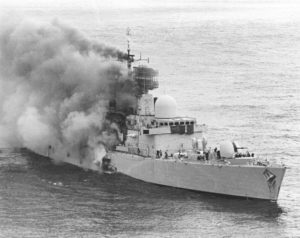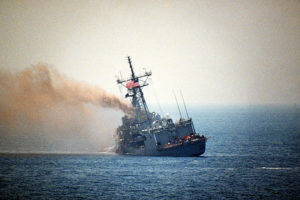The suggestion has been heard quite often from the local shipbuilding community that the Philippine government should avail of the capability of local shipyards to build naval surface combatant ships for the Philippine Navy in lieu of engaging foreign shipyards. If and when the government finally decides to do so, what must the local shipyards and shipbuilding ancillary industries know firsthand to be adequately prepared for such decision?
During the Shipbuilding and Maritime Exhibition /Symposium in June last year at the SMX Convention Center, Mall of Asia, Pasay City which was attended by representatives from these industries, MARINA requested this author for a presentation on some parameters for the design and construction of a warship ostensibly for the purpose of developing awareness and knowledge and prepare them to undertake shipbuilding projects for the Navy in the future.
The warship, an intricate system operating in a very complex environment made hostile by man in the words of British Navy Admiral of the Fleet Lord Chatfield, “must be built to fight and must be able to take some level of blows as well as to receive them”. It must be able to sail to an area at sea in order to exert her influence and show the sovereign power of a nation. A warship must therefore be designed for the effective control of the maritime sea lanes, exerting her influence to certain areas at sea and denying expected hostile forces the use and access of those areas.
The modern warship is first and foremost a weapons platform that must perform the role of fighting with sufficient seaworthiness to endure the climatic conditions prevailing in the area of operation.
Design and Selection Considerations
The design of a warship follows a rigorous set sequence of events:
First Stage – Naval Staff Requirement. Prepared by naval staff concerned, the requirements cover the following.
- Intelligence – Identifying the possible threat weapons, composition of the probable adversary, strength, strategy and tactics, climatic condition, prevailing sea condition, etc.;
- Personnel – Manning requirements, strength, budget, types of training, ratings needed, etc.;
- Operations – Operational requirements stated in broad terms, such as ratings, location of operating base, composition of forces, force mix, weapons on anti-air, anti-surface and anti-submarine, layered defense, offense, independent patrol or as a part of a larger task group, tidal flows, sea current and depth, the likelihood of severe swell or cross seas, distance to the nearest natural shelter and suitable anchorage, patrol area in square miles, prevailing sea condition, climatic extreme, etc.;
- Logistics – Identifying in broad terms the integrated logistic support requirements such as budget for the training, logistic support to sustain operation, fuel, lube oil, dry-docking, spare parts, ammunition, ordnance, and other quartermaster items, etc.;
- Plans & Programs – Specifications on the number and strength of platform needed, future growth and integration of the platform to the fleet, doctrine development, etc.;
- Budget – Capital Outlay needed to procure, support and maintain the ship from the budgetary requirements for the next 15 years (midlife refit) and 30 years (disposal stage). Etc.;
- Ships and Yards – Drydocking requirements, berthing, shore power, refueling, ship husbandry, sustainment, propulsion, economy of operation, survivability, operating profile, etc.;
- Combat System/Communication – Sensors and combat system requirements, ordnance, repair and maintenance, suppression of signature threshold, electronic warfare capability, weapon, etc.; and,
- Civil Military Operation – military operation other than War (MOOTW) search and rescue, disaster relief response, etc.
Second Stage – Formulation of the design concept.
Stated in broad terms of worthiness at sea and in battle, the design concept is formulated on the basis of a long list of factors that include but not limited to these: the characteristics of expected threat; effect of successful attack to the warship; susceptibility of the warship to various signature threshold; vulnerability elimination; recoverability; survivability; speed and power and economy of operation; maintainability; offensive and defensive capability in anti-surface, anti-air and anti-submarine weaponry; electronic warfare capability (electronic surveillance measures and countermeasures); ship system and sub-system reliability; detailed combat system capabilities tabulation and effectiveness; capability to defeat coordinated multiple attacking threats; life cycle cost; operating profile. Items that are known as the Circular of Requirements.
Third Stage – Formulation of the technical specifications and final blueprint.
At this stage, the shipyard designer and technician in hull, propulsion, weapons engineer, electronics engineer, logistician, and others formulate the preliminary and final technical specification and prepare the blueprint for building the warship, covering these: hull and superstructure; propulsion; auxiliaries; outfitting; sensors; weapons; habitability; navigation and electronics; communications; life-saving equipment; integrated logistic support
COEIAS
An acronym for Combined Operational Effectiveness and Investment Appraisal Study, it is an important parameter in warship design – the comparative evaluation and matching of capabilities of variety of sensors, weapons, speed and power, compartmentation, protection of the crew and vital equipment and the capability and capacity to defeat the incoming threat in terms of target acquisition, reduction of ship signature threshold matched against threat from the surface submarine and air. COEIAS encompasses the evaluation and assessment of the best option on the desired or requisite operational effectiveness versus cost implications to operate and maintain the overall systems for the next 30 years.
Survivability
Recent conflict at sea such as in the Falkland war in 1982 and the Gulf war in 1991 have recorded that modern warships, in spite of sophisticated sensors and active/offensive weapon system can still be badly hit and damaged.
Vividly grim pictures of the aftermath of recent conflicts at sea, the Falkland War in 1982 and the Gulf War in 1992 demonstrating the importance of ship design to withstand damage, must remain fresh in the minds of two of the powerful navies of the world:
- MS Antelope hit by Exocet Anti-Ship Missile from Argentine Air Force, April 2, 1982;
- HMS Coventry hit by bombs from Argentine Air Force, May 25, 1982;
- HMS Ardent hit by Exocet Anti-Ship Missile from Argentine Air Force, May 21, 1982;
- HMS Sheffield hit by Exocet Anti-Ship Missile from Argentine Air Force, April 2, 1982;
- USS Cole hit by explosives from the Al-Qaeda terrorist October 12, 2000;
- USS Robert listing to port after being hit by mines at the Persian Gulf on 14 April 1988;
- USS Stark hit by two Exocet missiles from Iraqi Sky Hawk in May 17, 198.
Current and future operational scenarios point to destructiveness in the modern conflict at sea, given the advancing technology in sensors and guided weapons system. Survivability of a warship would depend on the reduction of susceptibility to being hit by minimizing the so-called ship signature, the elements such as acoustics, emissions, etc. that the enemy use to track and inflict extreme damage to the warship.
These are some techniques of ship design to enhance ship survivability:
- Concentration – systems and sub-system components should be co-located in the smallest possible space and volume to reduce the chance of being hit and damage;
- Duplication – system and sub-system are installed in parallel arrangement for the reason of availability reliability and maintainability of some critical equipment;
- Separation – duplication of some critical equipment, sub-systems which can provide similar function should be separated from each other.
- Protection – provisions to resist the spread of damaged to critical areas which are vital to ship operation., to include watertight compartmentation;
- Zoning – vital services are grouped to each zones and should have own independent firefighting unit, smoke control, armor protection, ventilation system, etc.
- Reduction of ship signature threshold – is the means to avoid being hit by ordnance or guided weapon towards attraction to excessive signature threshold of the ship.
Life Cycle Cost
The pre-determination cost of a warship is a must, to establish the budgetary requirements needed by the navy throughout the life cycle of the warship – build, maintain, operate, sustain, retrofit-/mid-life refit all the way to its disposal. This will provide good overview, a good measure of the magnitude and budget implication to the fleet.
And on a final note, whether it is a parameter or not but certainly applicable in the design and construction of a warship as it is in many, if not all, that we do – Doing It “Right First Time.” Otherwise, the warship that was built to be an asset to the fleet becomes a liability, a veritable white elephant the fleet can and ought to do without.
Editor’s Note: About the Author: He attended training at Blomh and Voss, a German Shipbuilder in Hamburg, Germany building Frigates and Destroyers of Meko (Modular Construction) Design. Thereafter, he acquired further training and experience ship survivability and seakeeping analysis at the Hydrodynamics Laboratory of the United Kingdom Defense Evaluation Research agency (DERA) in Southampton and Hasslar United Kingdom of Great Britain under the sponsorship of UK Ministry of Defense, and Electronic Warfare training STN Atlas of Bremen, Germany and INDRA in Madrid, Spain.
As Commander of the Naval Shipbuilding Facility of the Naval Sea Systems Command of the Philippine Navy, he worked with the Technical Assistance Team (TAT) of the Navy Division, Joint US Military Advisory Group Technician and Engineers from Pearl Harbor Shipyard and Calderock Small Combat Craft in Virginia USA. During his tenure, the Naval Shipyard undertook the co-production of 21 units of 78 Aluminum Hull patrol gunboats – presently the workhorse of the PN in internal defense – from Halter Marine of New Orleans, USA: the first 12 units built in USA, the second by AG & P in Batangas and the last one built in the Naval Shipyard in Cavite City. Other of his projects include the Patrol Craft Escort (PCE) retrofit program and the re-engine project of the three PN capital ships.



